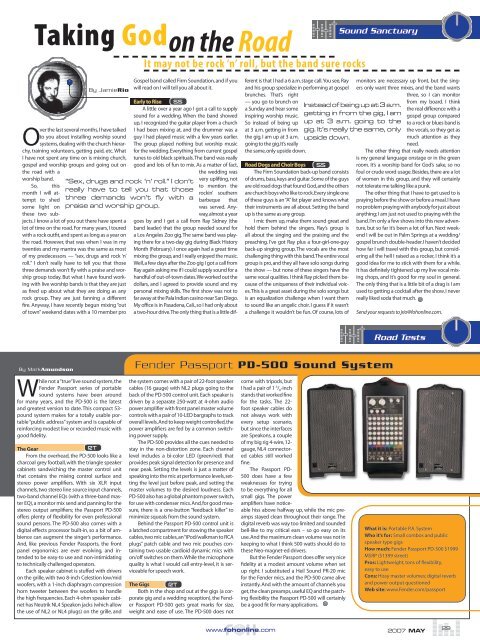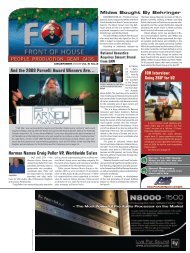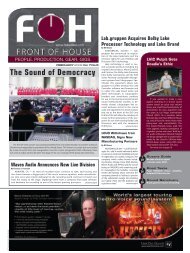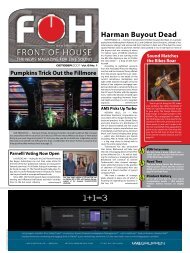May Issue - FOH Online
May Issue - FOH Online
May Issue - FOH Online
You also want an ePaper? Increase the reach of your titles
YUMPU automatically turns print PDFs into web optimized ePapers that Google loves.
Taking Godon the Road<br />
Over the last several months, I have talked<br />
to you about installing worship sound<br />
systems, dealing with the church hierarchy,<br />
training volunteers, getting paid, etc. What<br />
I have not spent any time on is mixing church,<br />
gospel and worship groups and going out on<br />
the road with a<br />
worship band.<br />
So, this<br />
month I will attempt<br />
to shed<br />
some light on<br />
these two subjects.<br />
I know a lot of you out there have spent a<br />
lot of time on the road. For many years, I toured<br />
with a rock outfit, and spent as long as a year on<br />
the road. However, that was when I was in my<br />
twenties and my mantra was the same as most<br />
of my predecessors — “sex, drugs and rock ‘n’<br />
roll.” I don’t really have to tell you that those<br />
three demands won’t fly with a praise and worship<br />
group today. But what I have found working<br />
with live worship bands is that they are just<br />
as fired up about what they are doing as any<br />
rock group. They are just fanning a different<br />
fire. Anyway, I have recently begun mixing “out<br />
of town” weekend dates with a 10 member pro<br />
By MarkAmundson<br />
By JamieRio<br />
Gospel band called Firm Soundation, and if you<br />
will read on I will tell you all about it.<br />
Early to Rise SS<br />
A little over a year ago I got a call to supply<br />
sound for a wedding. When the band showed<br />
up, I recognized the guitar player from a church<br />
I had been mixing at, and the drummer was a<br />
guy I had played music with a few years earlier.<br />
The group played nothing but worship music<br />
for the wedding. Everything from current gospel<br />
tunes to old black spirituals. The band was really<br />
good and lots of fun to mix. As a matter of fact,<br />
the wedding was<br />
very uplifting, not<br />
to mention the<br />
rockin’ southern<br />
barbeque that<br />
was served. Anyway,<br />
almost a year<br />
goes by and I get a call from Ray Sidney (the<br />
band leader) that the group needed sound for<br />
a Los Angeles Zoo gig. The same band was playing<br />
there for a two-day gig during Black History<br />
Month (February). I once again had a great time<br />
mixing the group, and I really enjoyed the music.<br />
Well, a few days after the Zoo gig I got a call from<br />
Ray again asking me if I could supply sound for a<br />
handful of out-of-town dates. We worked out the<br />
dollars, and I agreed to provide sound and my<br />
personal mixing skills. The first show was not to<br />
far away at the Pala Indian casino near San Diego.<br />
My office is in Pasadena, Cali., so I had only about<br />
a two-hour drive. The only thing that is a little dif-<br />
“Sex, drugs and rock ‘n’ roll.” I don’t<br />
really have to tell you that those<br />
three demands won’t fly with a<br />
praise and worship group.<br />
While not a “true” live sound system, the<br />
Fender Passport series of portable<br />
sound systems have been around<br />
for many years, and the PD-500 is the latest<br />
and greatest version to date. This compact 53pound<br />
system makes for a totally usable portable<br />
“public address” system and is capable of<br />
reinforcing modest live or recorded music with<br />
good fidelity.<br />
The Gear<br />
RT<br />
From the overhead, the PD-500 looks like a<br />
charcoal grey football, with the triangle speaker<br />
cabinets sandwiching the master control unit<br />
that contains the mixing control surface and<br />
stereo power amplifiers. With six XLR input<br />
channels, two stereo line source input channels,<br />
two-band channel EQs (with a three-band master<br />
EQ), a monitor mix send and panning for the<br />
stereo output amplifiers; the Passport PD-500<br />
offers plenty of flexibility for even professional<br />
sound persons. The PD-500 also comes with a<br />
digital effects processor built-in, so a bit of ambience<br />
can augment the singer’s performance.<br />
And, like previous Fender Passports, the front<br />
panel ergonomics are ever evolving, and intended<br />
to be easy-to use and non-intimidating<br />
to technically challenged operators.<br />
Each speaker cabinet is stuffed with drivers<br />
on the grille, with two 8-inch Celestion low/mid<br />
woofers, with a 1-inch diaphragm compression<br />
horn tweeter between the woofers to handle<br />
the high frequencies. Each 4-ohm speaker cabinet<br />
has Neutrik NL4 Speakon jacks (which allow<br />
the use of NL2 or NL4 plugs) on the grille, and<br />
It may not be rock ‘n’ roll, but the band sure rocks<br />
www.fohonline.com<br />
ferent is that I had a 6 a.m. stage call. You see, Ray<br />
and his group specialize in performing at gospel<br />
brunches. That’s right<br />
— you go to brunch on<br />
a Sunday and hear some<br />
inspiring worship music.<br />
So instead of being up<br />
at 3 a.m. getting in from<br />
the gig, I am up at 3 a.m.<br />
going to the gig. It’s really<br />
the same, only upside down.<br />
Road Dogs and Choir Boys SS<br />
The Firm Soundation back-up band consists<br />
of drums, bass, keys and guitar. Some of the guys<br />
are old road dogs that found God, and the others<br />
are church boys who like to rock. Every single one<br />
of these guys is an “A” list player and knows what<br />
their instruments are all about. Setting the band<br />
up is the same as any group.<br />
I mic them up, make them sound great and<br />
hold them behind the singers. Ray’s group is<br />
all about the singing and the praising and the<br />
preaching. I’ve got Ray plus a four-girl-one-guy<br />
back-up singing group. The vocals are the most<br />
challenging thing with this band. The entire vocal<br />
group is pro, and they all have solo songs during<br />
the show — but none of these singers have the<br />
same vocal qualities. I think Ray picked them because<br />
of the uniqueness of their individual voices.<br />
This is a great asset during the solo songs but<br />
is an equalization challenge when I want them<br />
to sound like an angelic choir. I guess if it wasn’t<br />
a challenge it wouldn’t be fun. Of course, lots of<br />
Sound Sanctuary<br />
Instead of being up at 3 a.m.<br />
getting in from the gig, I am<br />
up at 3 a.m. going to the<br />
gig. It’s really the same, only<br />
upside down.<br />
Fender Passport PD-500 Sound System<br />
the system comes with a pair of 22-foot speaker<br />
cables (16 gauge) with NL2 plugs going to the<br />
back of the PD-500 control unit. Each speaker is<br />
driven by a separate 250-watt at 4-ohm audio<br />
power amplifier with front panel master volume<br />
controls with a pair of 10-LED bargraphs to track<br />
overall levels. And to keep weight controlled, the<br />
power amplifiers are fed by a common switching<br />
power supply.<br />
The PD-500 provides all the cues needed to<br />
stay in the non-distortion zone. Each channel<br />
level includes a bi-color LED (green/red) that<br />
provides peak signal detection for presence and<br />
near peak. Setting the levels is just a matter of<br />
speaking into the mic at performance levels, setting<br />
the level just before peak, and setting the<br />
master volumes to the desired loudness. Each<br />
PD-500 also has a global phantom power switch,<br />
for use with condenser mics. And, for good measure,<br />
there is a one-button “feedback killer” to<br />
minimize squeals from the sound system.<br />
Behind the Passport PD-500 control unit is<br />
a latched compartment for stowing the speaker<br />
cables, two mic cables, an “iPod/walkman to RCA<br />
plugs” patch cable and two mic pouches containing<br />
two usable cardioid dynamic mics with<br />
on/off switches on them. While the microphone<br />
quality is what I would call entry-level, it is serviceable<br />
for speech work.<br />
The Gigs RT<br />
Both in the shop and out at the gigs (a corporate<br />
gig and a wedding reception), the Fender<br />
Passport PD-500 gets great marks for size,<br />
weight and ease of use. The PD-500 does not<br />
come with tripods, but<br />
I had a pair of 1 3 / 8-inch<br />
stands that worked fine<br />
for the tasks. The 22foot<br />
speaker cables do<br />
not always work with<br />
every setup scenario,<br />
but since the interfaces<br />
are Speakons, a couple<br />
of my big rig 4-wire, 12gauge,<br />
NL4 connectored<br />
cables still worked<br />
fine.<br />
The Passport PD-<br />
500 does have a few<br />
weaknesses for trying<br />
to be everything for all<br />
small gigs. The power<br />
amplifiers have noticeable<br />
hiss above halfway up, while the mic preamps<br />
stayed clean throughout their range. The<br />
digital reverb was way too limited and sounded<br />
bell-like to my critical ears – so go easy on its<br />
use. And the maximum clean volume was not in<br />
keeping to what I think 500 watts should do to<br />
these Neo-magnet-ed drivers.<br />
But the Fender Passport does offer very nice<br />
fidelity at a modest amount volume when set<br />
up right. I substituted a Heil Sound PR-20 mic<br />
for the Fender mics, and the PD-500 came alive<br />
instantly. And with the amount of channels you<br />
get, the clean preamps, useful EQ and the patching<br />
flexibility the Passport PD-500 will certainly<br />
be a good fit for many applications.<br />
monitors are necessary up front, but the singers<br />
only want three mixes, and the band wants<br />
three, so I can monitor<br />
from my board. I think<br />
the real difference with a<br />
gospel group compared<br />
to a rock or blues band is<br />
the vocals, so they get as<br />
much attention as they<br />
need.<br />
The other thing that really needs attention<br />
is my general language onstage or in the green<br />
room. It’s a worship band for God’s sake, so no<br />
foul or crude word usage. Besides, there are a lot<br />
of women in this group, and they will certainly<br />
not tolerate me talking like a punk.<br />
The other thing that I have to get used to is<br />
praying before the show or before a meal. I have<br />
no problem praying with anybody for just about<br />
anything; I am just not used to praying with the<br />
band. I’m only a few shows into this new adventure,<br />
but so far it’s been a lot of fun. Next weekend<br />
I will be out in Palm Springs at a wedding/<br />
gospel brunch double-header. I haven’t decided<br />
how far I will travel with this group, but considering<br />
all the hell I raised as a rocker, I think it’s a<br />
good idea for me to stick with them for a while.<br />
It has definitely tightened up my live vocal mixing<br />
chops, and it’s good for my soul in general.<br />
The only thing that is a little bit of a drag is I am<br />
used to getting a cocktail after the show. I never<br />
really liked soda that much.<br />
Send your requests to jrio@fohonline.com.<br />
Road Tests<br />
What it is: Portable P.A. System<br />
Who it’s for: Small combos and public<br />
speaker type gigs<br />
How much: Fender Passport PD-500 $1999<br />
MSRP ($1399 street)<br />
Pros: Lightweight, tons of flexibility,<br />
easy to use<br />
Cons: Hissy master volumes; digital reverb<br />
and power output questioned<br />
Web site: www.Fender.com/passport<br />
2007 MAY<br />
29

















